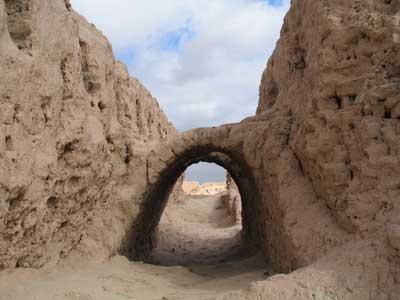Ayaz-Kala
History of the Fortress of Ancient Khorezm
On the colorful cliffs of one the Sultauizdag eastern spurs, in the Kyzyl Kum desert there survived ruins of one of the largest castles of ancient Khorezm– Ayaz-Kala.
Folk legends associate the name of the fortress of with the name of the legendary warrior-slave Ayaz. Ayaz is a Central Asian Turkic folklore hero. The semi-mythical hero, according to a legend, threw himself at an Amazon princess who lived in the Kirk-Kiz fortress.
The archaeologists claim that the Ayaz-Kala fortress belongs to the II century AD – a heyday of the Kushan Empire. Stretching in a chain from East to West it was part of a system of frontiers, built to protect the oasis on the side of the desert. All fortresses were located on a visible distance from each other, probably in order to make transmission of signals of approaching enemy convenient.
The Ayaz -Kala complex is interesting because unlike other castles of ancient Khorezm, it has unfortified rural settlements – a set of residential buildings, each with a large yard, enclosed by a low brick wall and planted, apparently, with gardens and orchards at the time. At one of the walls of the yard there is a relatively small detached house with 15 rooms, indicating that the process of separation of individual household from a tribal community had already begun at that time. Perhaps it was the home of a wealthy official or garrison commander.
Among dozens of unfortified farmhouses in the Ayaz-Kala complex, three fortresses-buildings stand out for their significant size. They are Ayaz-3, a giant fortress with a large courtyard surrounded by strong walls with towers and a maze near the gate. Near its north-eastern and north-western corners there are 40-room houses cross-cut with hallways.
The Ayaz-2 ruins sprung on a rock, also date back to the Kushan period, but reconstructed by the Afrigids in the V-VII centuries. On the cliff plateau, adjacent to the settlement there is Ayaz-1 with semicircular towers, a maze near the gate, arched gallery in the wall base and a well, cut in the center of the rock, which was a place for the livestock – the main wealth of the inhabitants–to gather around . In the north-east of Ayaz-1, there are remains of a watchtower.
Thus, Ayaz-Kala was neither a city nor a settlement, but a fortress complex, which accommodated Kushan border detachments nearly 19 centuries ago.
The Ayaz-Kala ruins have been hidden with the sands for millennia, but today thanks to numerous archaeological excavations, we can touch its ancient history.
Source: http://www.advantour.com/uzbekistan/karakalpakstan/ayaz-kala.htm


